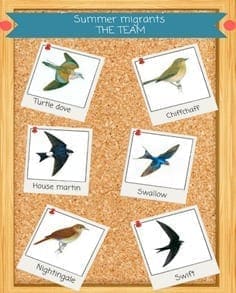Birds are flying to our shores to enjoy what we all hope will be a glorious summer. The RSPB has handy tips to help identify our visitors.
Migrant birds who have spent the winter in Africa are arriving on our shores.
Much-loved favourites like swifts, swallows and house martins will be seen and heard around houses, gardens and the countryside as spring does its thing, staying with us for several weeks before flying home for winter.
But it can be hard to tell some of these birds apart as they look quite similar, so the RSPB has put together a CV for each of the new arrivals, to help recognise who’s who.
The Team:
Swift: This superb flier can go months without ever touching the ground, eating, sleeping and breeding in flight. This means you almost never see a stationary one but they look black against the sky and have a slightly forked tail – but not as forked as the swallow. It’s their screams that make them unmistakable – listen out for ‘screaming parties’ flying low and fast around buildings, especially in the evenings.
Swallow: they have dark, glossy blue backs and a red patch under their chin. It’s their long, forked tails that make them easy to spot, and their song is more of a twitter, which they will perform from a perch like a fence or building. Swallows often hang out with their friends on telegraph wires.
House martin: They build their nests under the eaves of houses, and they are carefully constructed, muddy little sanctuaries. They also have a forked tail but it is shorter than the swallow’s. Their song sounds like ‘jik, jik.’ If the summer is dry, we can all help house martins by helping create mud for their nests – water a muddy patch in your garden or driveway, or fill in any spaces that have previously been puddles to help provide building material.
Chiffchaff: A busy, olive brown warbler, the chiffchaff flits through trees and shrubs, wagging its tail distinctively while looking for insects to pick out and snap while flying. They sometimes have a pale eye stripe, a bit like a mask. It gets its name from its song.
Nightingale: Nightingales are actually rather ordinary to look at – they’re slightly bigger than robins with brown feathers. They tend to ‘skulk’ and can be difficult to spot but once they start to sing they are catapulted to fame and few other birds can match their fast, high and low, rich notes. Sadly, the number of nightingales in England has declined by around 90% in the last half century, leaving less and less to bring their beautiful song to the English countryside.
Turtle dove: A beautiful, dainty dove that is much smaller than the collared doves you may see in your garden, about the size of a blackbird. The ‘purr’ from the turtle dove is a slightly haunting sound which truly signals summer but sadly we’ve lost 94% of them since 1995 and it’s a very real threat that they could become extinct.
For more information on summer migrants visit www.rspb.org.uk











